A Method for Judging the Effectiveness of Complex Tight Gas Reservoirs Based on Geophysical Logging Data and Using the L Block of the Ordos Basin as a Case Study
Abstract
1. Introduction
2. Geological Overview
3. Principle of the Method
3.1. Reservoir Effectiveness Identification Factor F1
3.2. Reservoir Effectiveness Identification Factor F2
4. Results and Discussion
4.1. Results
4.1.1. Model Building Process
4.1.2. Application Effect
4.2. Discussion
4.2.1. Method Comparison
4.2.2. Analysis of Resistivity Response Value
4.2.3. Error Analysis
4.2.4. Limitations
5. Conclusions
Author Contributions
Funding
Data Availability Statement
Acknowledgments
Conflicts of Interest
References
- Yin, S.; Lv, D.; Ding, W. New Method for Assessing Microfracture Stress Sensitivity in Tight Sandstone Reservoirs Based on Acoustic Experiments. Int. J. Geomech. 2018, 18, 1–16. [Google Scholar] [CrossRef]
- Liu, B.; Bai, L.; Chi, Y.; Jia, R.; Fu, X.; Yang, L. Geochemical characterization and quantitative evaluation of shale oil reservoir by two-dimensional nuclear magnetic resonance and quantitative grain fluorescence on extract: A case study from the Qingshankou Formation in Southern Songliao Basin, northeast China. Mar. Pet. Geol. 2019, 109, 561–573. [Google Scholar] [CrossRef]
- Li, Y.; Zhou, D.-H.; Wang, W.-H.; Jiang, T.-X.; Xue, Z.-J. Development of unconventional gas and technologies adopted in China. Energy Geosci. 2020, 1, 55–68. [Google Scholar] [CrossRef]
- Stow, D.; Nicholson, U.; Kearsey, S.; Tatum, D.; Gardiner, A.; Ghabra, A.; Jaweesh, M. The Pliocene-Recent Euphrates river system: Sediment facies and architecture as an analogue for subsurface reservoirs. Energy Geosci. 2020, 1, 174–193. [Google Scholar] [CrossRef]
- Yoshida, M.; Santosh, M. Energetics of the Solid Earth: An integrated perspective. Energy Geosci. 2020, 1, 28–35. [Google Scholar] [CrossRef]
- Zou, C.; Zhu, R.; Liu, K.; Su, L.; Bai, B.; Zhang, X.; Yuan, X.; Wang, J. Tight gas sandstone reservoirs in China: Characteristics and recognition criteria. J. Pet. Sci. Eng. 2012, 88–89, 82–91. [Google Scholar] [CrossRef]
- Santosh, M.; Feng, Z. New horizons in energy geosciences. Energy Geosci. 2020, 1, A1. [Google Scholar] [CrossRef]
- Nolte, S.; Fink, R.; Krooss, B.M.; Littke, R. Simultaneous determination of the effective stress coefficients for permeability and volumetric strain on a tight sandstone. J. Nat. Gas Sci. Eng. 2021, 95, 104186. [Google Scholar] [CrossRef]
- Shi, B.; Chang, X.; Liu, Z.; Liu, Y.; Ge, T.; Zhang, P.; Wang, Y.; Wang, Y.; Mao, L. Physical-property cutoffs of tight reservoirs by field and laboratory experiments: A case study from Chang 6, 8–9 in Ordos Basin. Front. Earth Sci. 2021, 15, 471–489. [Google Scholar] [CrossRef]
- Qassamipour, M.; Khodapanah, E.; Tabatabaei-Nezhad, S.A. A comprehensive method for determining net pay in exploration/development wells. J. Pet. Sci. Eng. 2020, 196, 107849. [Google Scholar] [CrossRef]
- Yang, T.; Cao, Y.; Wang, Y.; Liu, K.; He, C.; Zhang, S. Determining permeability cut-off values for net pay study of a low-permeability clastic reservoir: A case study of the Dongying Sag, eastern China. J. Pet. Sci. Eng. 2019, 178, 262–271. [Google Scholar] [CrossRef]
- Otchere, D.A.; Ganat, T.O.A.; Nta, V.; Brantson, E.T.; Sharma, T. Data analytics and Bayesian Optimised Extreme Gradient Boosting approach to estimate cut-offs from wireline logs for net reservoir and pay classification. Appl. Soft Comput. 2022, 120, 108680. [Google Scholar] [CrossRef]
- Worthington, P.F. The Application of Cutoffs in Integrated Reservoir Studies. SPE Reserv. Eval. Eng. 2008, 11, 968–975. [Google Scholar] [CrossRef]
- Masoudi, P.; Arbab, B.; Mohammadrezaei, H. Net pay determination by Dempster rule of combination: Case study on Iranian offshore oil fields. J. Pet. Sci. Eng. 2014, 123, 78–83. [Google Scholar] [CrossRef]
- Bouffin, N.; Jensen, J. Efficient Detection of Productive Intervals in Oil and Gas Reservoirs. In Proceedings of the Canadian International Petroleum Conference, Calgary, AB, Canada, 16–18 June 2009. [Google Scholar] [CrossRef]
- Wang, Y.; Cao, Y.; Song, G.; Song, L.; Yang, T.; Zhang, S. Analysis of petrophysical cutoffs of reservoir intervals with production capacity and with accumulation capacity in clastic reservoirs. Pet. Sci. 2014, 11, 211–219. [Google Scholar] [CrossRef]
- Worthington, P.F.; Cosentino, L. The Role of Cutoffs in Integrated Reservoir Studies. SPE Reserv. Eval. Eng. 2005, 8, 276–290. [Google Scholar] [CrossRef]
- Egbele, E.; Ezuka, I.; Onyekonwu, M. Net-to-gross ratios: Implications in integrated reservoir management studies. In Proceedings of the Nigeria Annual International Conference and Exhibition, Abuja, Nigeria, 1–3 August 2005. [Google Scholar]
- Mahbaz, S.; Sardar, H.; Namjouyan, M.; Mirzaahmadian, Y. Optimization of reservoir cut-off parameters: A case study in SW Iran. Pet. Geosci. 2011, 17, 355–363. [Google Scholar] [CrossRef]
- Harfoushian, J.H.; Suriyanto, O. Net Pay Cutoff Determination Using In-Situ Permeability Measurements with Advanced Formation Testers. In Proceedings of the SPE Asia Pacific Oil & Gas Conference and Exhibition, Perth, Australia, 25–27 October 2016. [Google Scholar] [CrossRef]
- Masoudi, P.; Tokhmechi, B.; Zahedi, A.; Jafari, M.A. Developing a method for identification of net zones using log data and diffusivity equation. Int. J. Min. Reclam. Environ. 2012, 2, 53–60. [Google Scholar] [CrossRef]
- Masoudi, P.; Tokhmechi, B.; Jafari, M.A.; Zamanzadeh, S.M.; Sherkati, S. Application of Bayesian in determining productive zones by well log data in oil wells. J. Pet. Sci. Eng. 2012, 94–95, 47–54. [Google Scholar] [CrossRef]
- Masoudi, P.; Arbab, B.; Mohammadrezaei, H. Net pay determination by artificial neural network: Case study on Iranian offshore oil fields. J. Pet. Sci. Eng. 2014, 123, 72–77. [Google Scholar] [CrossRef]
- Mehdipour, V.; Ziaee, B.; Motiei, H. Determination and distribution of petro physical parameters (PHIE, Sw and NTG) of Ilam Reservoir in one Iranian oil filed. Life Sci. J. 2013, 10, 153–161. [Google Scholar] [CrossRef]
- Gao, H.; Li, H. Determination of movable fluid percentage and movable fluid porosity in ultra-low permeability sandstone using nuclear magnetic resonance (NMR) technique. J. Pet. Sci. Eng. 2015, 133, 258–267. [Google Scholar] [CrossRef]
- Zheng, S.; Yao, Y.; Liu, D.; Cai, Y.; Liu, Y. Characterizations of full-scale pore size distribution, porosity and permeability of coals: A novel methodology by nuclear magnetic resonance and fractal analysis theory. Int. J. Coal Geol. 2018, 196, 148–158. [Google Scholar] [CrossRef]
- Zhang, S.; Wang, J.; Zhang, Y.; Zhang, X.; Zhang, T.; Cui, J. Determination of petrophysical property cutoffs of lacustrine dolomite intercrystalline pore reservoir in the Xiaganchaigou Formation, western Qaidam Basin. Acta Pet. Sin. 2021, 42, 44–45+118. [Google Scholar] [CrossRef]
- Yang, Z.; Tang, X.; Xiao, H.; Zhang, F.; Jiang, Z.; Liu, G. Water film thickness of tight reservoir in Fuyu oil layer of Cretaceous Quantou Formation in Songliao Basin and its influence on the lower limit of seepage. Mar. Pet. Geol. 2022, 139, 105592. [Google Scholar] [CrossRef]
- Qin, B.; Cao, B.; Zhou, J.; Zhang, L.; Lei, Y.; Zhang, Z. Availability identification of tight gas sandstone reservoirs and quantitative assessment: A case study from the first member of the Upper Paleozoic Shanxi Formation in the southeastern Ordos Basin. Acta Sedimentol. Sin. 2019, 37, 403–405. [Google Scholar] [CrossRef]
- Mi, H.; Zhang, B.; Zhu, G.; Su, Y.; Zhang, H. Geological characteristics and development potential analysis of Linxin tight sandstone gas reservoir. Spec. Oil Gas Reserv. 2022, 29, 65–72. [Google Scholar] [CrossRef]
- Zhu, G.; Li, B.; Li, Z.; Du, J.; Liu, Y.; Wu, L. Practices and development trend of unconventional natural gas explorationin eastern margin of Ordos Basin: Taking Linxing-Shenfu gas field as an example. China Offshore Oil Gas 2022, 34, 16–29+261. [Google Scholar] [CrossRef]
- Zhao, J.; Liu, L.; Li, X.; Zhou, G.; Wang, X. Review and forecast of technique research on fluid identification of low and particularly low permeability sandstone reservoir. Prog. Geophys. 2009, 24, 1446–1453. [Google Scholar] [CrossRef]
- Zhu, L.; Wu, S.; Zhou, X.; Cai, J. Saturation evaluation for fine-grained sediments. Geosci. Front. 2023, 14, 101540. [Google Scholar] [CrossRef]
- Guo, J.; Ling, Z.; Xu, X.; Zhao, Y.; Yang, C.; Wei, B.; Zhang, Z.; Zhang, C.; Tang, X.; Chen, T.; et al. Saturation Determination and Fluid Identification in Carbonate Rocks Based on Well Logging Data: A Middle Eastern Case Study. Processes 2023, 11, 1282. [Google Scholar] [CrossRef]
- Archie, G.E. The Electrical Resistivity Log as an Aid in Determining Some Reservoir Characteristics. Trans. AIME 1942, 146, 54–62. [Google Scholar] [CrossRef]
- Wu, Y.; Hu, X.; Yang, D.; Wu, J.; Yuan, W. A new method of obtaining core irreducible water saturation based on capillary pressure curve. Bull. Geol. Sci. Technol. 2018, 37, 100–105. [Google Scholar] [CrossRef]
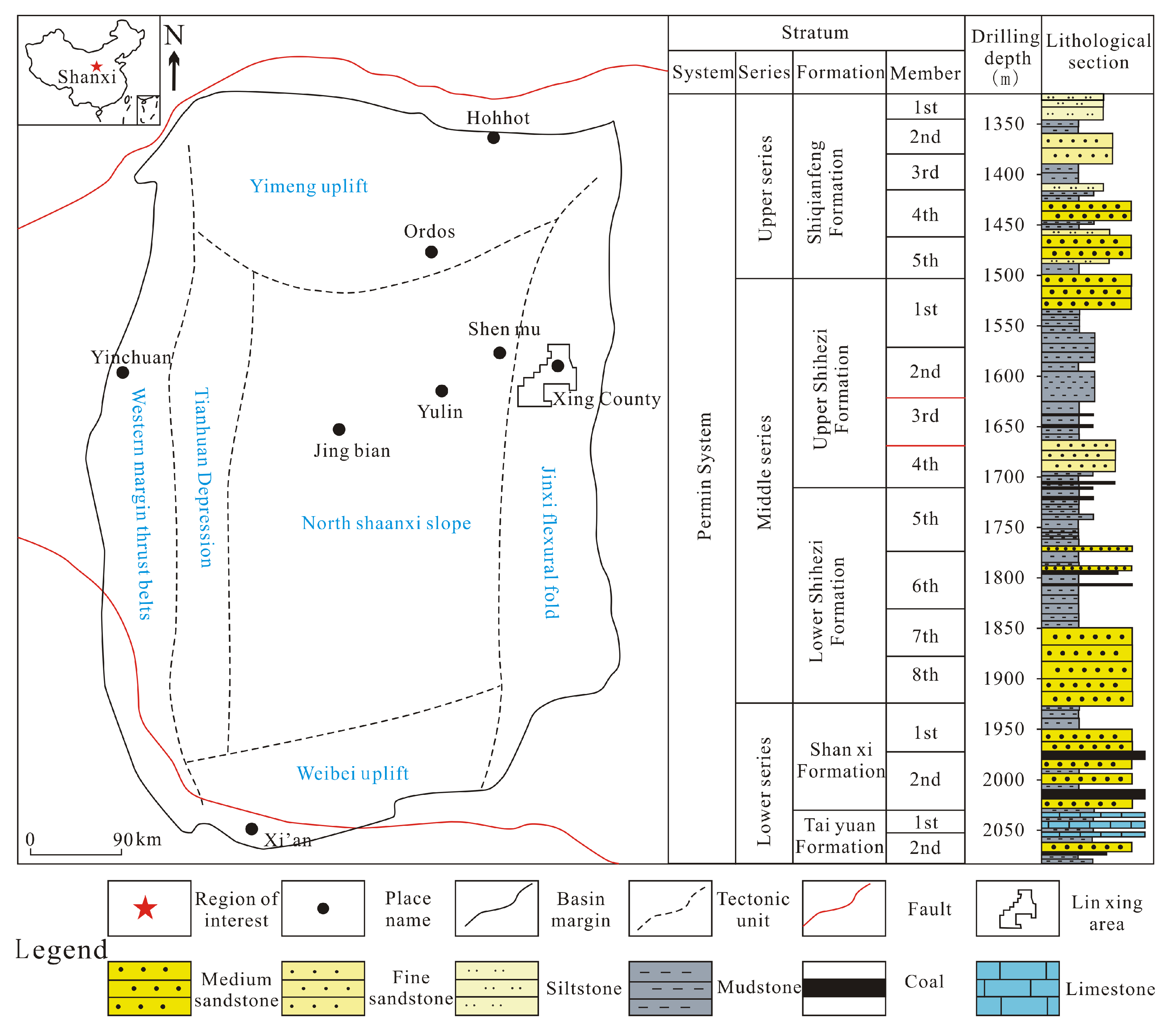
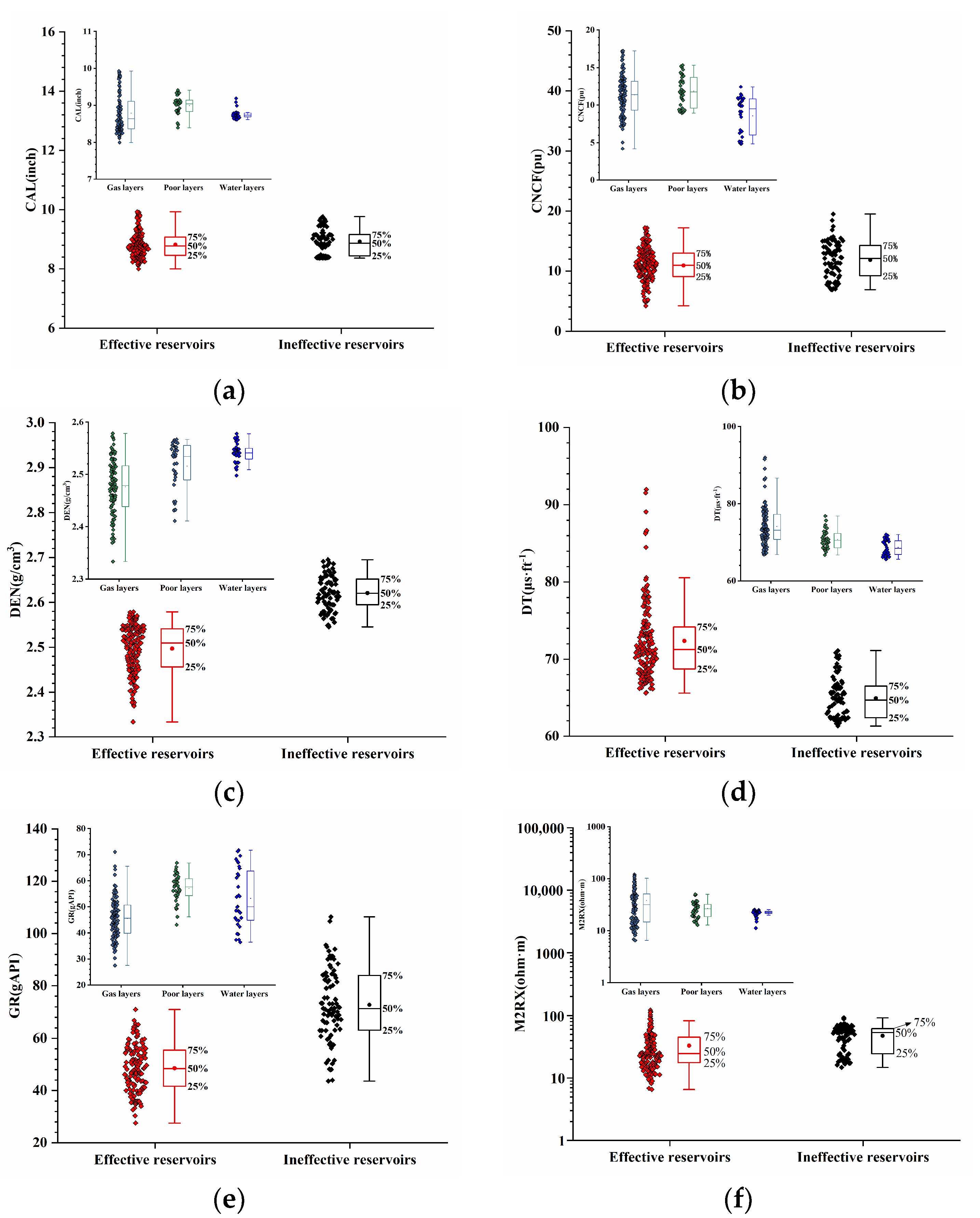

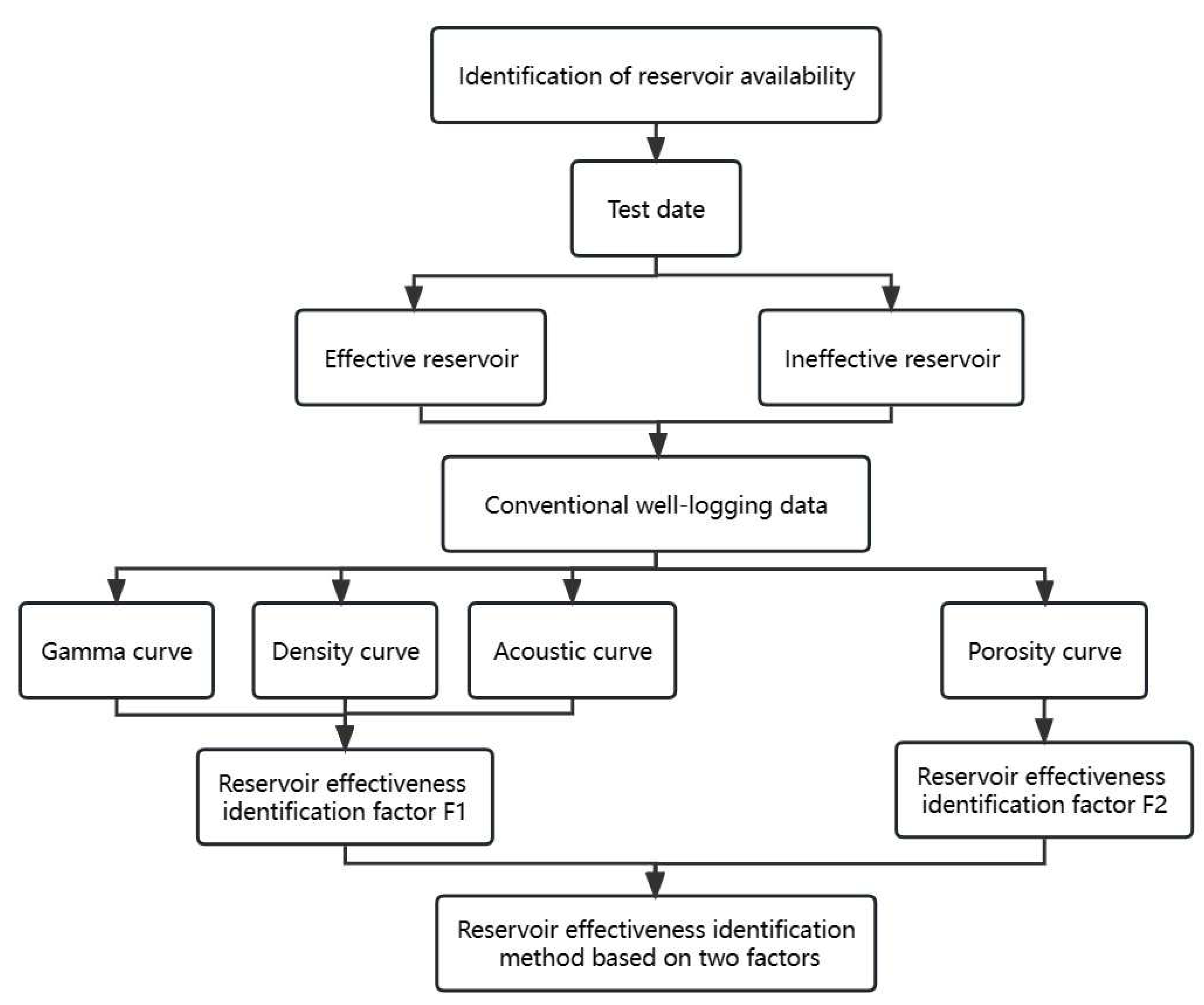
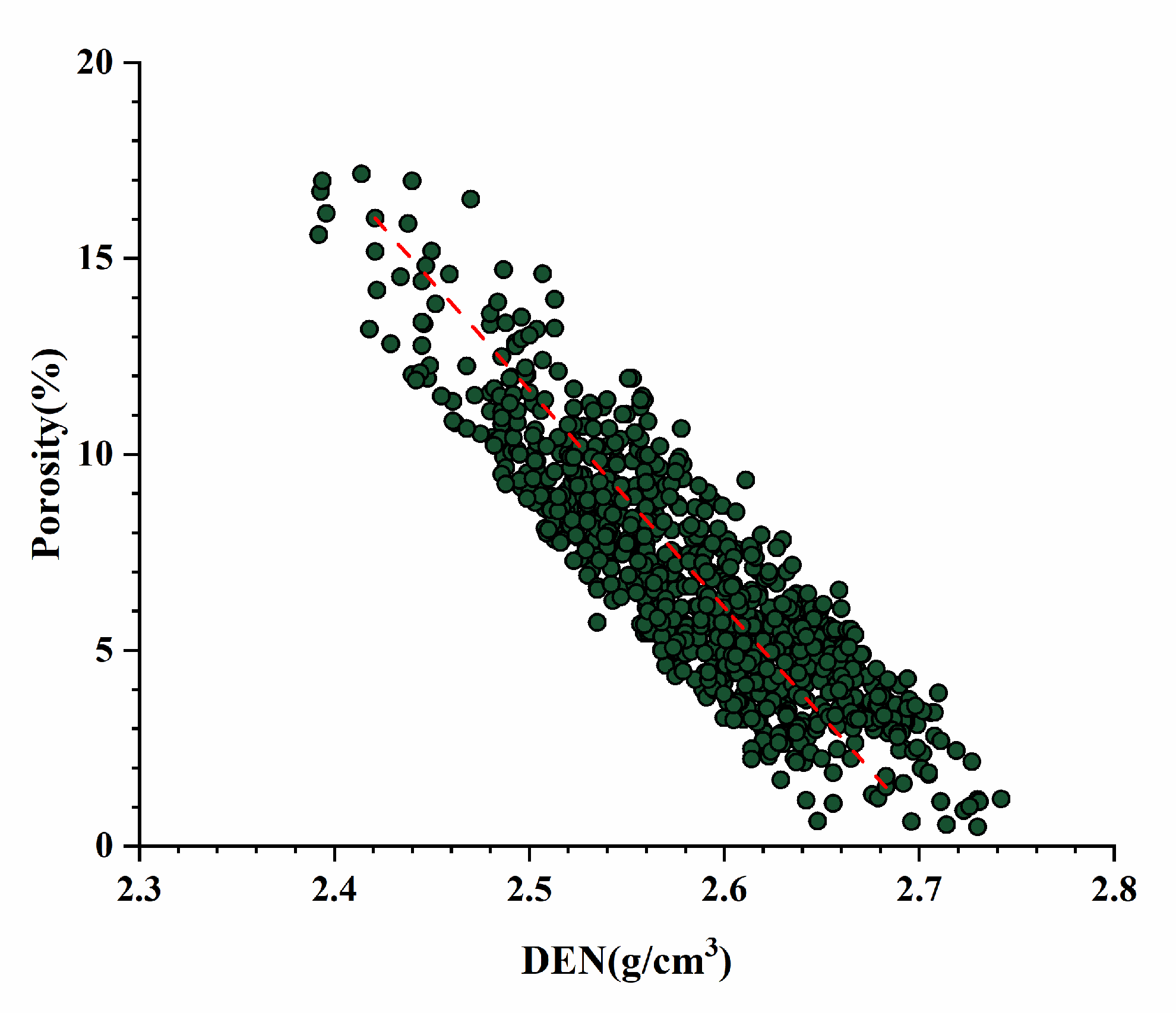

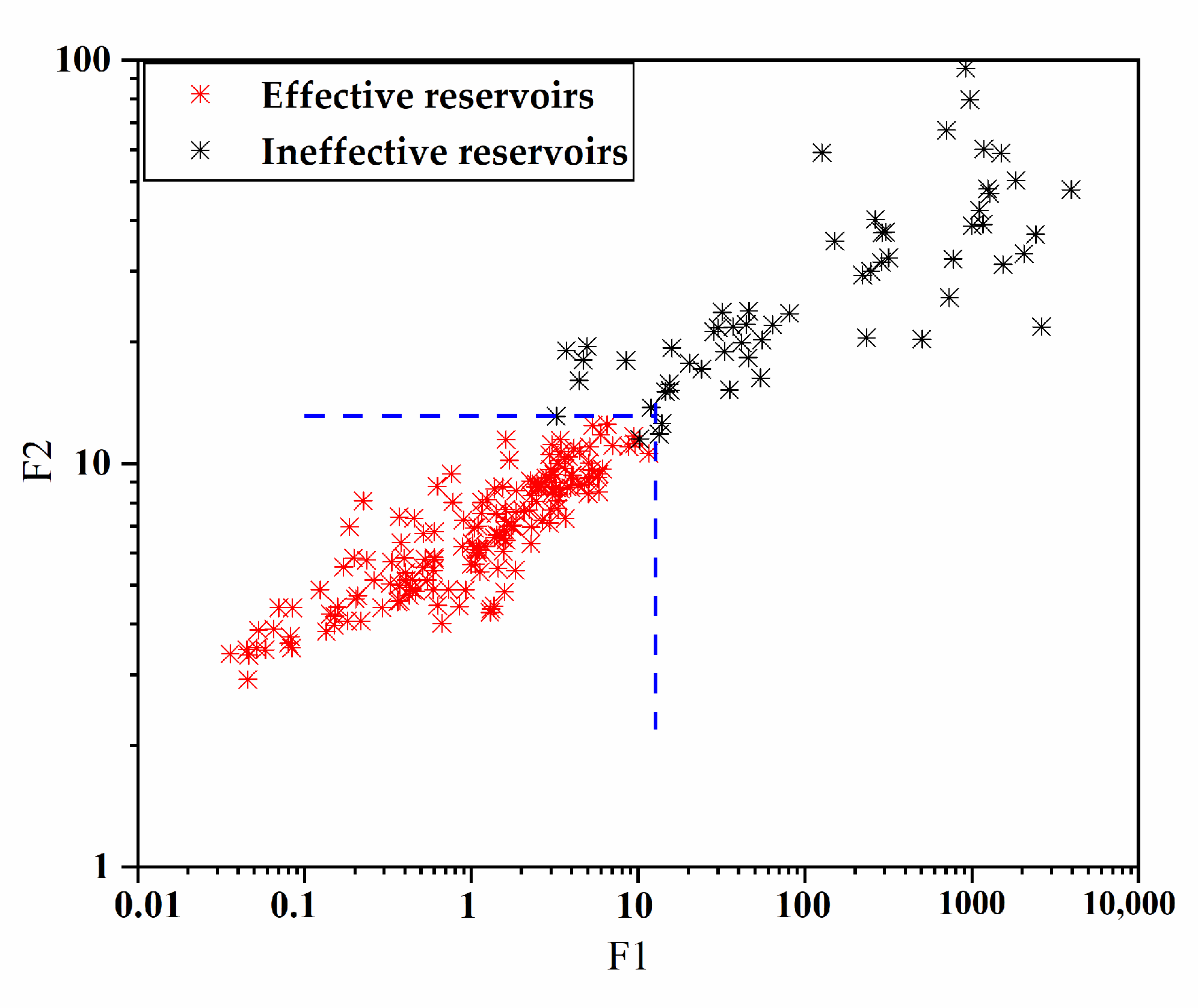

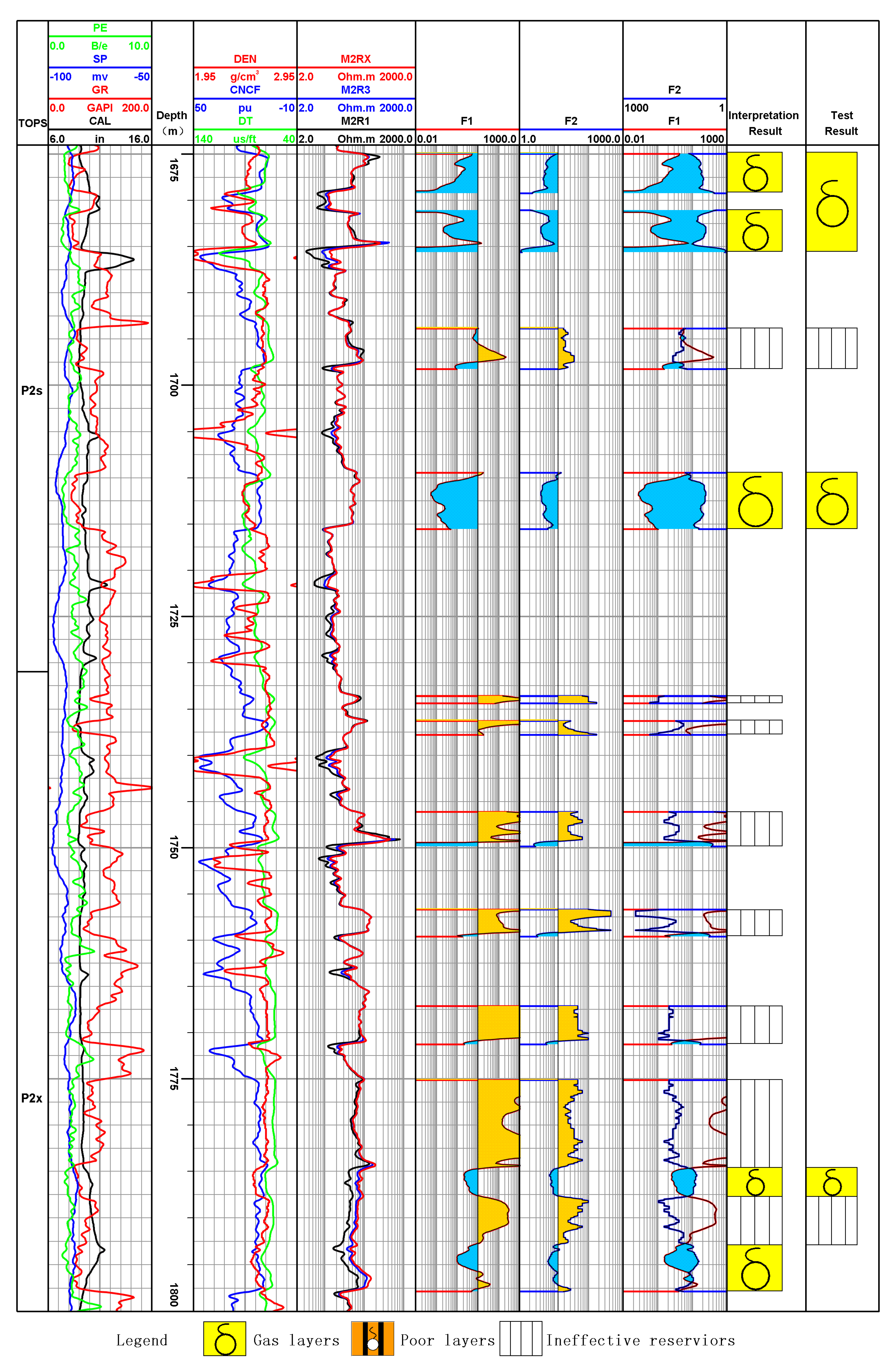

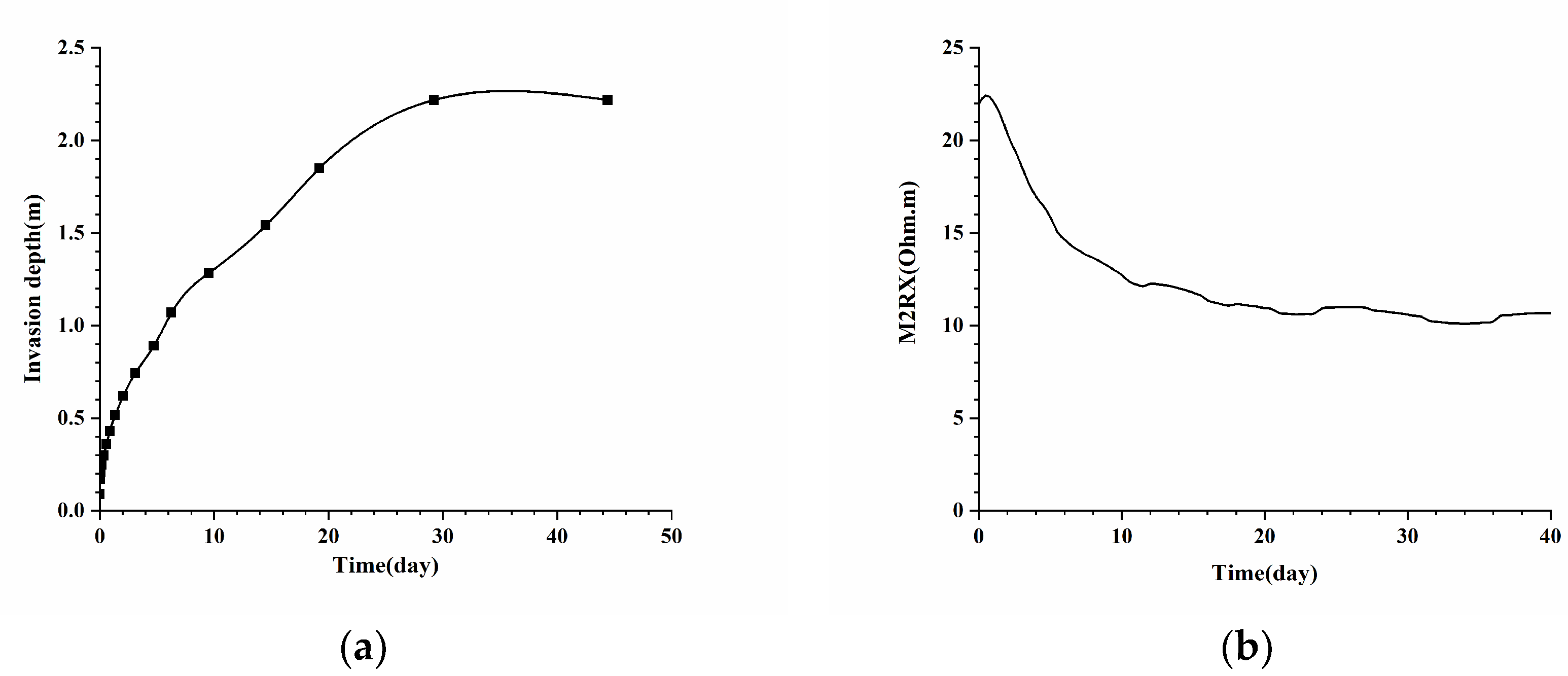
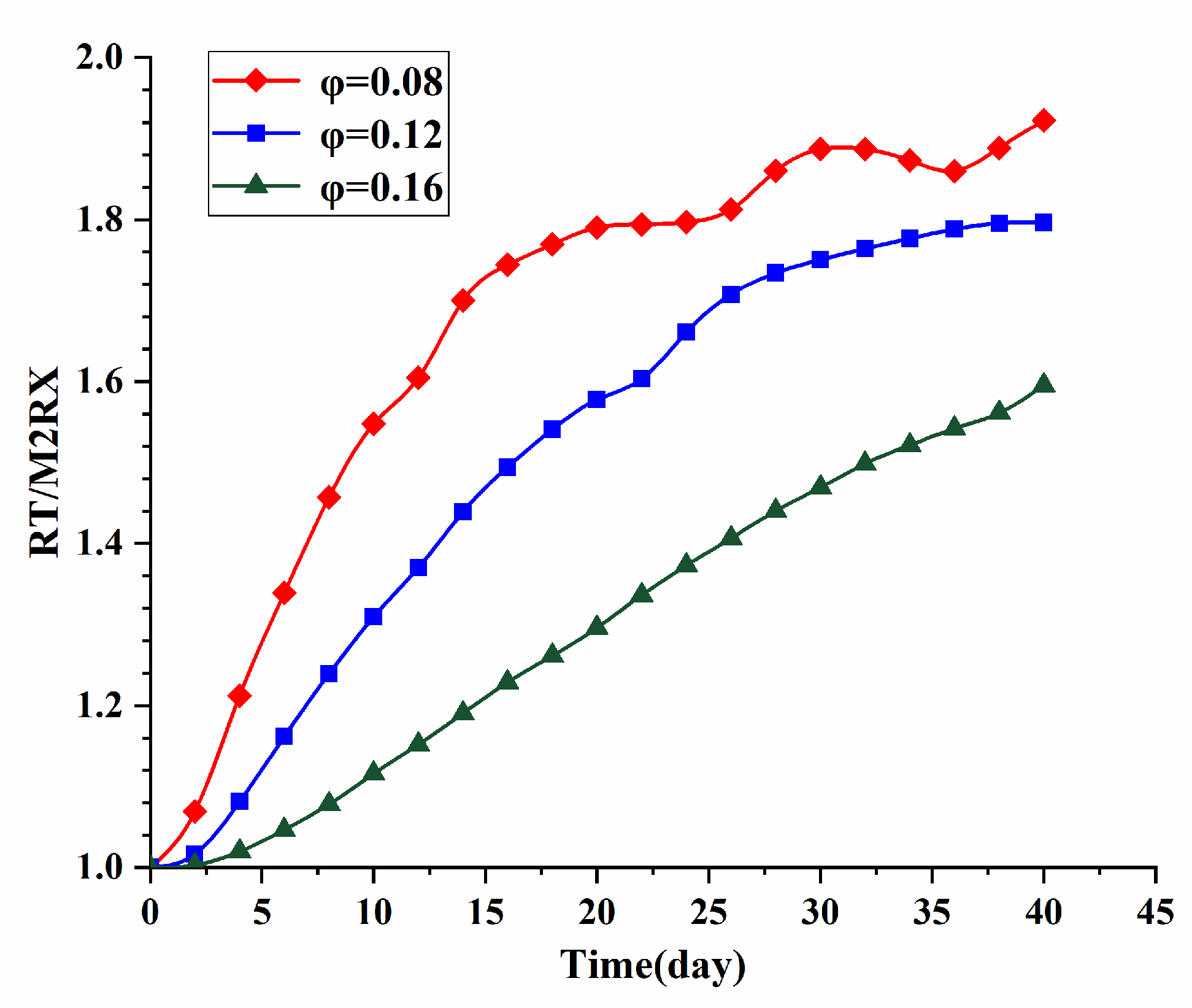

| Reservoir Effectiveness Identification Factor | Effective Reservoir |
|---|---|
| 0 < < 10 | |
| 0 < < 13 |
| Accuracy (96%) | ||
|---|---|---|
| Test Results | Effective Reservoir | Ineffective Reservoir |
| Effective reservoir | 21 (100%) | 0 (0%) |
| Ineffective reservoir | 1 (20%) | 4 (80%) |
| Method | Accuracy Rate |
|---|---|
| Double-factor method | 96% |
| Porosity–permeability crossplot method | 78.2% |
| Mercury injection curve method | 70.3% |
Disclaimer/Publisher’s Note: The statements, opinions and data contained in all publications are solely those of the individual author(s) and contributor(s) and not of MDPI and/or the editor(s). MDPI and/or the editor(s) disclaim responsibility for any injury to people or property resulting from any ideas, methods, instructions or products referred to in the content. |
© 2023 by the authors. Licensee MDPI, Basel, Switzerland. This article is an open access article distributed under the terms and conditions of the Creative Commons Attribution (CC BY) license (https://creativecommons.org/licenses/by/4.0/).
Share and Cite
Zhao, Q.; Guo, J.; Zhang, Z. A Method for Judging the Effectiveness of Complex Tight Gas Reservoirs Based on Geophysical Logging Data and Using the L Block of the Ordos Basin as a Case Study. Processes 2023, 11, 2195. https://doi.org/10.3390/pr11072195
Zhao Q, Guo J, Zhang Z. A Method for Judging the Effectiveness of Complex Tight Gas Reservoirs Based on Geophysical Logging Data and Using the L Block of the Ordos Basin as a Case Study. Processes. 2023; 11(7):2195. https://doi.org/10.3390/pr11072195
Chicago/Turabian StyleZhao, Qing, Jianhong Guo, and Zhansong Zhang. 2023. "A Method for Judging the Effectiveness of Complex Tight Gas Reservoirs Based on Geophysical Logging Data and Using the L Block of the Ordos Basin as a Case Study" Processes 11, no. 7: 2195. https://doi.org/10.3390/pr11072195
APA StyleZhao, Q., Guo, J., & Zhang, Z. (2023). A Method for Judging the Effectiveness of Complex Tight Gas Reservoirs Based on Geophysical Logging Data and Using the L Block of the Ordos Basin as a Case Study. Processes, 11(7), 2195. https://doi.org/10.3390/pr11072195









